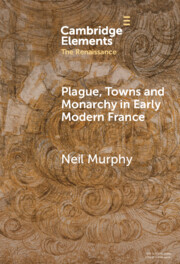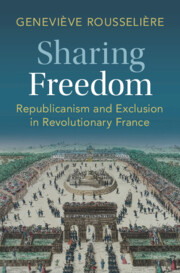633 results
2 - The Gramscian Right, or Turning Gramsci on His Head
-
- Book:
- World of the Right
- Print publication:
- 27 June 2024, pp 34-66
-
- Chapter
- Export citation
Chapter 20 - Culinary Longings
- from Part III - Cultural Transfers
-
-
- Book:
- Europe in British Literature and Culture
- Print publication:
- 13 June 2024, pp 322-336
-
- Chapter
- Export citation
Chapter 17 - More or Less English
- from Part III - Cultural Transfers
-
-
- Book:
- Europe in British Literature and Culture
- Print publication:
- 13 June 2024, pp 275-289
-
- Chapter
- Export citation
Myth 19 - That Darwin Faced a Conspiracy of Silence in Lamarck’s Country
-
-
- Book:
- Darwin Mythology
- Published online:
- 30 May 2024
- Print publication:
- 06 June 2024, pp 216-227
-
- Chapter
- Export citation
Chapter 27 - France
- from Part V - World Cultures Inspiration and Reception
-
-
- Book:
- Goethe in Context
- Published online:
- 16 May 2024
- Print publication:
- 23 May 2024, pp 263-271
-
- Chapter
- Export citation
Chapter 4 - Feminine Beginnings: Women’s Critical Perspectives on Debussy (1897–1914)
- from Part I - Paris: City, Politics, and Society
-
-
- Book:
- Debussy in Context
- Published online:
- 23 May 2024
- Print publication:
- 23 May 2024, pp 34-44
-
- Chapter
- Export citation

Anticultism in France
- Scientology, Religious Freedom, and the Future of New and Minority Religions
-
- Published online:
- 21 May 2024
- Print publication:
- 13 June 2024
-
- Element
- Export citation
13 - Sex in Eighteenth-Century Paris
-
-
- Book:
- The Cambridge World History of Sexualities
- Published online:
- 26 April 2024
- Print publication:
- 16 May 2024, pp 261-284
-
- Chapter
- Export citation
The Sale of Offices, Corruption, and Formalization: A Comparative Study of China and France in the Seventeenth and Eighteenth Centuries
-
- Journal:
- Asian Journal of Law and Society , First View
- Published online by Cambridge University Press:
- 29 April 2024, pp. 1-17
-
- Article
-
- You have access
- HTML
- Export citation

Plague, Towns and Monarchy in Early Modern France
-
- Published online:
- 25 April 2024
- Print publication:
- 25 April 2024
-
- Element
- Export citation
Context counts: an exploration of the situational correlates of meat consumption in three Western European countries
-
- Journal:
- Behavioural Public Policy , First View
- Published online by Cambridge University Press:
- 24 April 2024, pp. 1-16
-
- Article
-
- You have access
- Open access
- HTML
- Export citation
4 - ‘No Security, Except in Destruction’
-
- Book:
- Menacing Tides
- Published online:
- 11 April 2024
- Print publication:
- 18 April 2024, pp 167-239
-
- Chapter
- Export citation
5 - Beyond the Littoral
-
- Book:
- Menacing Tides
- Published online:
- 11 April 2024
- Print publication:
- 18 April 2024, pp 240-292
-
- Chapter
- Export citation
Pacifying the Battlefield of Industry: Warfare and Social Rights in 1848 France
-
- Journal:
- International Labor and Working-Class History , First View
- Published online by Cambridge University Press:
- 05 April 2024, pp. 1-16
-
- Article
-
- You have access
- Open access
- HTML
- Export citation
Chapter 30 - Interwar Continental Reception
- from Part VI - Reception
-
-
- Book:
- Vaughan Williams in Context
- Published online:
- 28 March 2024
- Print publication:
- 04 April 2024, pp 259-268
-
- Chapter
- Export citation
Conclusion
- from Stage 3 - After World War Two
-
- Book:
- Applied Science
- Published online:
- 15 March 2024
- Print publication:
- 28 March 2024, pp 255-262
-
- Chapter
- Export citation
1 - Contesting the Moral High Ground
-
- Book:
- Race, Taste and the Grape
- Published online:
- 16 March 2024
- Print publication:
- 28 March 2024, pp 37-72
-
- Chapter
- Export citation
1 - The Development of Pretoria’s Nuclear Industry and Relations with the IAEA, 1950–1977
-
- Book:
- Disarming Apartheid
- Published online:
- 28 March 2024
- Print publication:
- 28 March 2024, pp 16-39
-
- Chapter
- Export citation
2 - Applied Science Institutionalised
- from Stage 1 - Origins and Pedagogy in the Nineteenth Century
-
- Book:
- Applied Science
- Published online:
- 15 March 2024
- Print publication:
- 28 March 2024, pp 44-65
-
- Chapter
- Export citation

Sharing Freedom
- Republicanism and Exclusion in Revolutionary France
-
- Published online:
- 28 March 2024
- Print publication:
- 04 April 2024



